Birds
Media
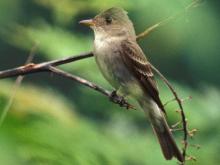
Species Types
Scientific Name
Contopus virens
Description
Its distinctive, slurred “pee-a-wee” song helps differentiate the eastern wood-pewee from our other flycatchers, and from most other small, olive-brown birds.
Media

Species Types
Scientific Name
Sayornis phoebe
Description
Eastern phoebes often build their mud-and-plant nests on the side of a house, just under a roof or other overhang. These small flycatchers repeatedly cry out their own name: “FEE-bee! FEE-bee!”
Media

Species Types
Scientific Name
Empidonax virescens
Description
The Acadian flycatcher is one of several flycatchers found in Missouri. It is a summer resident here, and like its relatives, it is much appreciated for its appetite for flying insects.
Media

Species Types
Scientific Name
Streptopelia decaocto
Description
The Eurasian collared-dove was introduced in the Bahamas and has rapidly spread throughout most of the United States. At first glance, it looks like a chunky, pale gray mourning dove.
Media
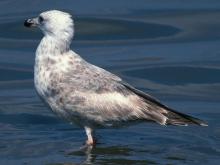
Species Types
Scientific Name
Larus argentatus
Description
Herring gulls are one of the three most common gulls found in Missouri. Adults can be told from our other common gulls by their pinkish legs and yellow bill with a small red dot near the tip.
Media

Species Types
Scientific Name
Nyctanassa violacea
Description
Adult yellow-crowned night-herons have black heads with creamy white cheek patches and crown. Night-herons are named for their habit of foraging mostly in the evening.
Media
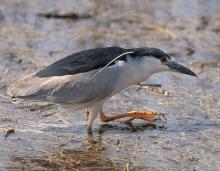
Species Types
Scientific Name
Nycticorax nycticorax
Description
Stocky and short-legged compared to other herons, the black-crowned night-heron has a black crown and back, gray wings, and whitish-gray underparts and head.
Media
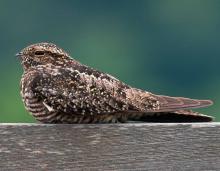
Species Types
Scientific Name
Chordeiles minor
Description
At night, common nighthawks fly, with quick flaps, glides, and darting movements, around lights pursuing flying insects. They are brown with a white mark on the underside of each narrow wing.
Media
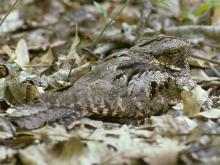
Species Types
Scientific Name
Antrostomus vociferus (formerly Caprimulgus vociferus)
Description
Although many people hear the evening calls of whip-poor-wills, few ever see these birds because by day they crouch on the ground amid fallen leaves, where they are perfectly camouflaged.
Media

Species Types
Scientific Name
Bombycilla cedrorum
Description
Sleek, crested cedar waxwings gather in large, relatively quiet groups to eat berries from shrubs and trees. The voice is a high-pitched, whizzy trill.
See Also







Media

Species Types
Scientific Name
Hemaris diffinis
Description
The snowberry clearwing is a moth that confuses people because it looks like a bumblebee and flies like a hummingbird!
Media

Species Types
Scientific Name
Hyles lineata
Description
The white-lined sphinx moth sometimes confuses people because it flies, hovers, and eats from flowers like a hummingbird. The adults often fly during daylight hours as well as in the night and are often found at lights.
Media

Species Types
Scientific Name
Darapsa myron
Description
The Virginia creeper sphinx moth is common in woods and brushy areas and comes to lights at night. The larvae eat Virginia creeper and grape leaves.
Media

Species Types
Scientific Name
Perimyotis subflavus (formerly Pipistrellus subflavus)
Description
Tri-colored bats, formerly called eastern pipistrelles, are relatively small and look pale yellowish or pale reddish brown. The main hairs are dark gray at the base, broadly banded with yellowish brown, and tipped with dark brown.
Media

Species Types
Scientific Name
Myotis grisescens
Description
Gray myotises are difficult to distinguish from other mouse-eared bats. A key identifying feature of the gray myotis is that its wing is attached to the ankle and not at the base of the toes. It’s an endangered species.
Media

Species Types
Scientific Name
Myotis lucifugus
Description
The little brown myotis (little brown bat) is one of our most common bats, but populations are declining. White-nose syndrome has taken a heavy toll in northeastern states. This species is now listed as vulnerable across its range.
Media

Species Types
Scientific Name
Myotis sodalis
Description
The Indiana myotis, or Indiana bat, summers along streams and rivers in north Missouri, raising its young under the bark of certain trees. It is an endangered species.
About Birds in Missouri
About 350 species of birds are likely to be seen in Missouri, though nearly 400 have been recorded within our borders. Most people know a bird when they see one — it has feathers, wings, and a bill. Birds are warm-blooded, and most species can fly. Many migrate hundreds or thousands of miles. Birds lay hard-shelled eggs (often in a nest), and the parents care for the young. Many communicate with songs and calls.





















